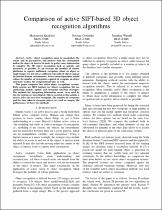JavaScript is disabled for your browser. Some features of this site may not work without it.
- ResearchSpace
- →
- Research Publications/Outputs
- →
- Conference Publications
- →
- View Item
| dc.contributor.author |
Keaikitse, M

|
|
| dc.contributor.author |
Govender, Nicolin

|
|
| dc.contributor.author |
Warrell, J

|
|
| dc.date.accessioned | 2014-06-17T09:15:48Z | |
| dc.date.available | 2014-06-17T09:15:48Z | |
| dc.date.issued | 2013-09 | |
| dc.identifier.citation | Keaikitse, M., Govender, N. and Warrell, J. 2013. Comparison of active SIFT-based 3D object recognition algorithms. In: Africon 2013, Mauritius, 9-13 September 2013 | en_US |
| dc.identifier.uri | http://ieeexplore.ieee.org/stamp/stamp.jsp?tp=&arnumber=6757615 | |
| dc.identifier.uri | http://hdl.handle.net/10204/7439 | |
| dc.description | Africon 2013, Mauritius, 9-13 September 2013 | en_US |
| dc.description.abstract | Active object recognition aims to manipulate the sensor and its parameters, and interact with the environment and/or the object of interest in order to gather more information to complete the 3D object recognition task as quickly and accurately as possible. It can leverage the mobility of robotic platforms to capture additional viewpoints about an object as single images are not always sufficient especially if objects appear in cluttered human environments. Active vision algorithms should reduce the number of viewpoints required to recognise an object and hence reduce the computational time as well. This paper compares two active object recognition systems. Both systems use SIFT features for object recognition, but use contrasting models, update and viewpoint selection strategies. The methods for integrating information across views used by the two systems are investigated. This is essential as this module is used to select the next best viewpoint. The number of viewpoints and the time taken to recognise objects are used to compare the performance of these two methods. | en_US |
| dc.language.iso | en | en_US |
| dc.publisher | IEEE Xplore | en_US |
| dc.relation.ispartofseries | Workflow;11490 | |
| dc.subject | 3D object recognition algorithms | en_US |
| dc.subject | Active vision | en_US |
| dc.subject | Robotic platforms | en_US |
| dc.subject | Object recognition | en_US |
| dc.subject | Single images | en_US |
| dc.subject | Cluttered human environments | en_US |
| dc.subject | Active vision algorithms | en_US |
| dc.subject | SIFT | en_US |
| dc.title | Comparison of active SIFT-based 3D object recognition algorithms | en_US |
| dc.type | Conference Presentation | en_US |
| dc.identifier.apacitation | Keaikitse, M., Govender, N., & Warrell, J. (2013). Comparison of active SIFT-based 3D object recognition algorithms. IEEE Xplore. http://hdl.handle.net/10204/7439 | en_ZA |
| dc.identifier.chicagocitation | Keaikitse, M, Nicolin Govender, and J Warrell. "Comparison of active SIFT-based 3D object recognition algorithms." (2013): http://hdl.handle.net/10204/7439 | en_ZA |
| dc.identifier.vancouvercitation | Keaikitse M, Govender N, Warrell J, Comparison of active SIFT-based 3D object recognition algorithms; IEEE Xplore; 2013. http://hdl.handle.net/10204/7439 . | en_ZA |
| dc.identifier.ris | TY - Conference Presentation AU - Keaikitse, M AU - Govender, Nicolin AU - Warrell, J AB - Active object recognition aims to manipulate the sensor and its parameters, and interact with the environment and/or the object of interest in order to gather more information to complete the 3D object recognition task as quickly and accurately as possible. It can leverage the mobility of robotic platforms to capture additional viewpoints about an object as single images are not always sufficient especially if objects appear in cluttered human environments. Active vision algorithms should reduce the number of viewpoints required to recognise an object and hence reduce the computational time as well. This paper compares two active object recognition systems. Both systems use SIFT features for object recognition, but use contrasting models, update and viewpoint selection strategies. The methods for integrating information across views used by the two systems are investigated. This is essential as this module is used to select the next best viewpoint. The number of viewpoints and the time taken to recognise objects are used to compare the performance of these two methods. DA - 2013-09 DB - ResearchSpace DP - CSIR KW - 3D object recognition algorithms KW - Active vision KW - Robotic platforms KW - Object recognition KW - Single images KW - Cluttered human environments KW - Active vision algorithms KW - SIFT LK - https://researchspace.csir.co.za PY - 2013 T1 - Comparison of active SIFT-based 3D object recognition algorithms TI - Comparison of active SIFT-based 3D object recognition algorithms UR - http://hdl.handle.net/10204/7439 ER - | en_ZA |






